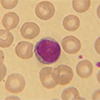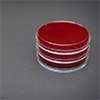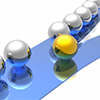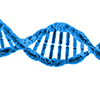Cellular Pathology - Andrology
Andrology
The laboratory's priority is to provide a comprehensive semen analysis service for Consultants, Urologists and General Practitioners from the Birmingham and Solihull area. This includes semen analysis (Diagnostic Semen Analysis), post-operative analysis of semen following a vasectomy operation (Post Vasectomy Semen Analysis) and Retrograde analysis of urine.
The laboratory operates on a clinic based service and has a maximum capacity of 2000 appointments available per annum. This covers the annual workload of routine diagnostic semen analysis, post-vasectomy samples and retrograde ejaculation analysis. Routinely patients will be given an appointment to attend the Andrology Department for on-site sample production in a designated private clinic room, however in exceptional circumstances samples may be produced off site if then able to be delivered to the laboratory within an appropriate time interval.
The UHB Andrology Laboratory has fully trained scientists who are highly proficient in performing quality diagnostic semen analysis in line with World Health Organisation (2021) and the 2016 Laboratory Guidelines for post vasectomy semen analysis. The laboratory regularly performs internal quality control, participates in the UK National External Quality Assurance Reproductive scheme for Andrology (UKNEQAS) and liaises with other accredited laboratories for comparison of tests not covered within the UKNEQAS scope.
A laboratory referral can be made via:
- Paper copy referral forms sent to Appointment Centre via post/e-mail
- Electronic Referral Service (e-RS) with an attached referral form
A copy of the referral form can be obtained by;
- Contacting the laboratory directly on 0121 424 9717 Or by accessing the word version at:
Andrology referrals
Off-site production can be arranged by the patient by telephoning the laboratory on 0121 424 9717 or by e-mailing This email address is being protected from spambots. You need JavaScript enabled to view it. (if you e-mail you are accepting that the connection is not secure and potentially not confidential – laboratory staff will minimise data transmission but cannot guarantee security). Please note that retrograde urine production must be on-site at Good Hope Hospital.
Turnaround Time: 7-10 days (electronic reporting may be more rapid). Paper copies sent out following result authorisation.
Anti-sperm antibodies (ASAB) are not tested at this laboratory. Agglutination is described if noted.
Accreditation information can be found under Cellular Pathology (UKAS 10141):
https://www.ukas.com/download-schedule/10141/Medical/
Post-vasectomy Semen Analysis (PVSA)
The laboratory undertakes examination procedures in line with the following guidelines: 2016 PVSA Guidelines. This will give clinicians information regarding clearance criteria.
Results are available to Hospital clinicians via PICS, Clinical Portal, and ICE.
GP’s can access patient results through their own electronic result systems.
Key details of the service:
- Operates Monday to Friday 08:00am to 16:00pm
- Undertakes Diagnostic semen analysis, Post vasectomy semen analysis and Retrograde examination (urine)
- Appointment based with on-site private room for sample production
- 7-10 day turnaround time (electronic and paper copy reporting)
- Patients are booked within 7 weeks from referral, unless clinically indicated or by patient choice
Please see user handbook for additional information including contact details:
Andrology User Handbook
Andrology - Measurement Uncertainty
Following on from our recent UKAS assessment, we were advised that we need to demonstrate that the clinical impact of the Measurement of Uncertainty on clinical decision values has been assessed and considered in relation to patient outcome. This must include an explanation of any effects this could have to the decision limits and how they should be interpreted.
Diagnostic Semen Analysis
Application of the Coefficient of Variation (CV) to the Clinical Relevance of Diagnostic Semen Analysis (DSA)
The Coefficient of Variation (CV) was calculated for each Diagnostic Semen Analysis (DSA) parameter and used as a measure of the associated analytical uncertainty. The CV values were derived from internal quality control (IQC) data collected over the previous 12 months. The calculated CVs are summarised below:
|
Parameter |
CV |
CV % |
|
Motility |
6.84 |
0.07 |
|
Concentration |
10.17 |
0.10 |
|
Morphology |
20.63 |
0.21 |
|
Vitality |
3.37 |
0.03 |
Uncertainty is calculated by dividing the analysis result by 100 and multiplying by the associated CV. The measurement range is then expressed as the reported result ± the calculated uncertainty.
The potential clinical impact of measurement uncertainty is particularly relevant for results that fall close to clinical decision thresholds. The table below provides examples using the CV values above.
|
Parameter |
Example Result |
Calculated Uncertainty |
Reported Range |
|
Motility |
30% |
±2.1% |
27.9–32.1% |
|
Concentration |
16 × 10⁶/mL |
±1.6 × 10⁶/mL |
14.4–17.6 × 10⁶/mL |
|
Morphology |
4% |
±0.8% |
3.2–4.8% |
|
Vitality |
54% |
±1.8% |
52.2–55.8% |
Understanding and communicating these uncertainties is essential when interpreting results near diagnostic cut-offs, as they may influence clinical decisions within the fertility pathway.
The clinical relevance of measurement uncertainty will be communicated to service users annually via website updates. Internal users (fertility and urology teams) will be informed directly by email.
Post Vasectomy Semen Analysis
To ensure compliance with the clearance levels of the 2016 post vasectomy guidelines (<100, 000 sperm/ml) the laboratory have ensured that sperm can be detected in samples that contain 876.9 sperm/ml (as ascertained through multiple dilutions).
Retrograde Analysis
Retrograde samples have multiple factors that can influence the uncertainty of the results. The laboratory has established a limit of detection for sperm of 175.4 sperm/ml.
Clinical Impact of Measurement Uncertainty
Measurement uncertainty, either for one reported parameter or as a combination of multiple reported parameters could have a clinical impact. For example, if a concentration of 15 x 10⁶/ml is reported (oligozoospermia), given a UoM of 1.4 x 10⁶/ml, this sample could have a concentration of 16 x 10⁶/ml (normozoospermia).
For some users, a diagnosis of oligozoospermia, even at the borderline level of 15 x 10⁶/ml, could lead to the recommendation of an assisted reproductive technology such as intracytoplasmic sperm injection (ICSI) to promote the chance of fertilisation, when conventional IVF, or even natural conception, might be possible.
We inform our users of this uncertainty and emphasize that the reports can be used to guide clinicians to determine how to proceed with further investigation and management of a subfertile couple. We stress that all reported parameters should be considered holistically.
Furthermore, as per WHO 2021 guidance, we inform users that many known and unknown female factors hamper the value of using only semen examination parameters to predict the prognosis for the couple of spontaneous or assisted fertilization.
The decision limits that we provide on our reports are derived from WHO 2021 and are derived from data characterizing the semen characteristics of a reference population (men whose partners had a time to pregnancy of 12 months or less). The data uses a diverse international populations, noting that the percentiles used do not represent distinct limits between fertile and subfertile men.
We highlight that a semen analysis is never prognostic of fertility, as it is the fertility potential of the couple that defines them as fertile or subfertile.
Department of Cellular Pathology
- Created on .
- Last updated on .
- Hits: 10106







